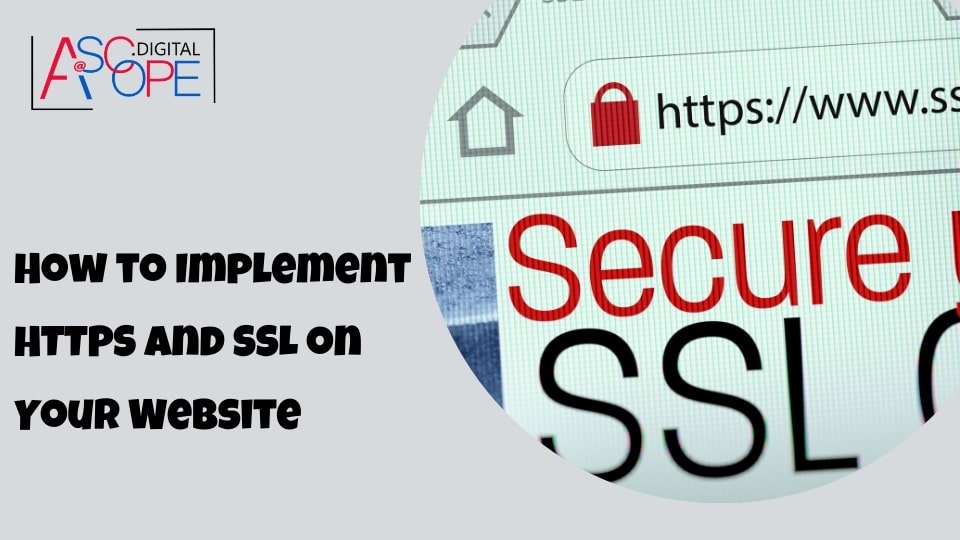In the contemporary digital landscape, website security is paramount. With the increase in cyber threats and data breaches, ensuring that your website is secure is no longer an option but a necessity. One of the most effective ways to secure your website is by implementing HTTPS and SSL. This comprehensive guide will take you through everything you need to know about HTTPS and SSL, and how to implement them on your website.
Understanding HTTPS and SSL
What is HTTPS?
HTTPS stands for HyperText Transfer Protocol Secure. It is an extension of HTTP, where the ‘S’ stands for Secure. This protocol is used to secure communication over a computer network, primarily the Internet. HTTPS ensures that the data exchanged between the web server and the user’s browser remains encrypted and secure from eavesdroppers.
What is SSL?
SSL, or Secure Sockets Layer, is a standard security protocol that establishes encrypted links between a web server and a browser. SSL ensures that all data passed between the web server and browsers remain private and integral. When SSL is implemented, it activates the HTTPS protocol, thereby securing your website.
Why Are HTTPS and SSL Important?
The importance of HTTPS and SSL cannot be overstated. Here are some critical reasons why you should implement them on your website:
- Data Security: SSL encrypts data, ensuring that sensitive information such as login credentials, credit card details, and personal information are secure.
- Authentication: SSL provides authentication, ensuring that users are communicating with the legitimate server and not a fraudulent one.
- Trust and Credibility: Websites with HTTPS are perceived as more trustworthy. The presence of a padlock icon in the browser’s address bar increases users’ confidence.
- SEO Benefits: Google and other search engines give preference to secure websites. Thus, implementing HTTPS can improve your search engine rankings, ultimately improving traffic and sales for your website. Read more on the other reasons why your website isn’t getting traffic.
Steps to Implement HTTPS and SSL

Step 1: Choose an SSL Certificate
The first step in implementing HTTPS and SSL is to choose an SSL certificate. There are several types of SSL certificates available, each catering to different needs:
- Domain Validated (DV) SSL: This is the most basic type of SSL certificate, providing a low level of validation. It is suitable for small websites and blogs.
- Organization Validated (OV) SSL: This certificate offers a higher level of validation, confirming that the organization is legitimate. It is ideal for small to medium-sized businesses.
- Extended Validation (EV) SSL: This is the highest level of SSL certificate, providing the most thorough validation. It is recommended for large enterprises and e-commerce websites.
- Wildcard SSL: This certificate secures a single domain and all its subdomains.
- Multi-Domain SSL: This certificate secures multiple domains with a single certificate.
Step 2: Purchase and Install the SSL Certificate
Once you have chosen the appropriate SSL certificate, the next step is to purchase and install it. Here’s how you can do it:
- Purchase the SSL Certificate: You can buy SSL certificates from a Certificate Authority (CA) or a trusted vendor. Some popular CAs include Comodo, Symantec, and GoDaddy.
- Generate a CSR (Certificate Signing Request): A CSR is a block of encoded text that contains information about your organization and domain. You need to generate a CSR and submit it to the CA.
- Validation: Depending on the type of SSL certificate you purchased, the CA will perform the necessary validation checks.
- Installation: Once the CA has validated your request, you will receive the SSL certificate. You need to install this certificate on your web server. The installation process varies depending on the web server you are using (Apache, Nginx, etc.).
Step 3: Configure Your Server for HTTPS
After installing the SSL certificate, you need to configure your server to use HTTPS. Here’s how you can do it for some common web servers:
For Apache
- Open the Configuration File: Locate and open your Apache configuration file (usually
httpd.conforapache2.conf). - Enable SSL Module: Ensure that the SSL module is enabled. You can do this by adding or uncommenting the following line: LoadModule ssl_module modules/mod_ssl.so
- Add Virtual Host for SSL: Add a Virtual Host for port 443 (HTTPS). Here’s an example:
<VirtualHost *:443>
ServerName www.yourdomain.com
DocumentRoot /var/www/htmlSSLEngine on
SSLCertificateFile /path/to/your/certificate.crt
SSLCertificateKeyFile /path/to/your/private.key
SSLCertificateChainFile /path/to/your/chainfile.pem
</VirtualHost> - Restart Apache: Save the changes and restart Apache for the new configuration to take effect: sudo systemctl restart apache2
For Nginx
- Open the Configuration File: Locate and open your Nginx configuration file (usually
nginx.confor a specific site configuration file). - Add Server Block for SSL: Add a server block for port 443 (HTTPS). Here’s an example:server {
listen 443 ssl;
server_name www.yourdomain.com;ssl_certificate /path/to/your/certificate.crt;
ssl_certificate_key /path/to/your/private.key;root /var/www/html;
index index.html index.htm;
} - Redirect HTTP to HTTPS: To ensure that all traffic is secured, you should redirect HTTP requests to HTTPS. Add the following server block:
server {
listen 80;
server_name www.yourdomain.com;return 301 https://$server_name$request_uri;
} - Restart Nginx: Save the changes and restart Nginx for the new configuration to take effect:
sudo systemctl restart nginx
Step 4: Update Your Website
After configuring your server to use HTTPS, you need to update your website to ensure that all resources are loaded over HTTPS. This includes:
- Updating Internal Links: Update all internal links to use HTTPS. This can often be done using a find-and-replace function in your website’s code or content management system (CMS).
- Updating External Resources: Ensure that any external resources (such as scripts, images, and stylesheets) are loaded over HTTPS. If these resources are not available over HTTPS, you should consider hosting them on your own server.
- Mixed Content: Mixed content occurs when a secure webpage (HTTPS) loads insecure resources (HTTP). Mixed content can lead to security warnings in browsers and should be avoided. Use browser developer tools to identify and fix mixed content issues.
Step 5: Test Your Configuration
After making all the necessary changes, it is crucial to test your configuration to ensure everything is working correctly. Here are some tools and techniques you can use:
- SSL Labs’ SSL Test: This free tool from Qualys SSL Labs performs a deep analysis of your SSL configuration and provides a detailed report. It also gives your website an overall grade (A+ being the best).
- Browser Testing: Open your website in different browsers and check for any security warnings or errors. Ensure that the padlock icon is visible in the address bar.
- Check for Mixed Content: Use browser developer tools to check for mixed content warnings and ensure that all resources are loaded over HTTPS.
- Online Validators: Use online tools like Why No Padlock? to check for common SSL issues and mixed content.
Step 6: Update Your Sitemap and Robots.txt
After successfully implementing HTTPS, update your sitemap and robots.txt file to reflect the change. This helps search engines to re-index your site correctly.
- Update Sitemap: Ensure that your sitemap includes the HTTPS versions of your URLs. If you use a CMS like WordPress, plugins like Yoast SEO can help you regenerate your sitemap.
- Update Robots.txt: If your
robots.txtfile includes any URLs, update them to use HTTPS.
Step 7: Monitor and Maintain
Implementing HTTPS and SSL is not a one-time task. Continuous monitoring and maintenance are essential to ensure your website remains secure. Here’s what you should do:
- Monitor SSL Certificate Expiry: SSL certificates have an expiration date. Monitor the expiry date and renew the certificate before it expires to avoid any downtime.
- Security Updates: Keep your server software and applications up-to-date with the latest security patches and updates.
- Regular Audits: Conduct regular security audits to identify and fix potential vulnerabilities.
- Log Monitoring: Monitor server logs for any unusual activity or security breaches.
Benefits of Implementing HTTPS and SSL
Implementing HTTPS and SSL on your website offers numerous benefits, including:
- Enhanced Security: HTTPS encrypts data, ensuring that sensitive information is protected from eavesdroppers and hackers.
- Improved SEO: Search engines like Google give preference to secure websites. Implementing HTTPS can improve your search engine rankings, leading to increased traffic and visibility.
- Increased Trust and Credibility: Users are more likely to trust websites that are secure. The presence of a padlock icon in the browser’s address bar reassures users that their data is safe.
- Better Performance: HTTPS can improve website performance, particularly with the implementation of HTTP/2, which offers faster page load times and improved efficiency.
- Compliance with Regulations: Many regulations and standards, such as GDPR and PCI DSS, require the use of HTTPS to protect user data.
Common Challenges and Solutions

Challenge 1: Mixed Content
Mixed content is a common issue when transitioning to HTTPS. It occurs when a secure webpage loads insecure resources. Here’s how you can address it:
- Identify Mixed Content: Use browser developer tools or online tools to identify mixed content warnings.
- Update URLs: Update all URLs to use HTTPS. This includes internal links, external resources, and third-party scripts.
- Host Resources Locally: If an external resource is not available over HTTPS, consider hosting it on your own server.
Challenge 2: SSL Certificate Errors
SSL certificate errors can occur due to various reasons, such as an expired certificate, incorrect installation, or mismatched domain names. Here’s how to resolve them:
- Check Expiry Date: Ensure that your SSL certificate is valid and not expired. Renew the certificate if necessary.
- Verify Installation: Verify that the SSL certificate is installed correctly on your server. Use online tools to check for installation errors.
- Match Domain Names: Ensure that the domain name in the SSL certificate matches the domain name of your website. Wildcard and multi-domain certificates can help if you have multiple subdomains or domains.
Challenge 3: Performance Issues
Implementing HTTPS can sometimes lead to performance issues, especially if not configured correctly. Here’s how to optimize performance:
- Enable HTTP/2: HTTP/2 is a major revision of the HTTP protocol that offers significant performance improvements. Ensure that your server supports and is configured to use HTTP/2.
- Optimize SSL/TLS Configuration: Optimize your SSL/TLS configuration to ensure the best performance. This includes using modern cipher suites and enabling features like OCSP stapling.
- Use a CDN: A Content Delivery Network (CDN) can help improve performance by caching and delivering content from servers closer to the user.
Conclusion
Implementing HTTPS and SSL on your website is crucial for ensuring data security, improving SEO, and building trust with your users. By following the steps outlined in this guide, you can successfully transition your website to HTTPS and enjoy the numerous benefits it offers. Remember to choose the appropriate SSL certificate, configure your server correctly, and continuously monitor and maintain your security setup. By doing so, you will not only protect your users but also enhance your website’s performance and credibility.
Thus, improving traffic and sales for your website. Read more on the other reasons why your website isn’t getting traffic.
Ensuring the security of your website through HTTPS and SSL is a proactive step towards safeguarding your digital presence and fostering a secure and trustworthy environment for your users. Start the transition today and reap the benefits of a secure and optimized website


